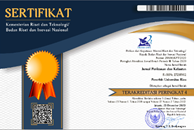Fisheries Management of Terubuk (Tenualosa macrura) with an Ecosystem Approach (EAFM) in the Bengkalis Strait, Bengkalis Regency, Riau Province
(1) Department of Marine Science, Postgraduate, Universitas Riau
(2) Department of Aquatic Resources Management, Faculty of Fisheries and Marine, Universitas Riau
(3) Department of Aquatic Resources Management, Faculty of Fisheries and Marine, Universitas Riau
(*) Corresponding Author
Abstract
Keywords
Full Text:
PDFReferences
[BPS] Badan Pusat Statistik Kabupaten Bengkalis. (2021). Kabupaten Bengkalis dalam Angka 2021. ISSN:0215-3866. BPS Kabupaten Bengkalis. 268 p.
[DJPT-KKP] Direktorat Jenderal Perikanan Tangkap Kementerian Kelautan dan Perikanan. (2016). Penilaian Indikator EAFM sebagai Evaluasi Pengelolaan Sumber Daya Ikan Demersal di WPPN RI. Jakarta (ID): DJPT-KKP.
[KKP] Kementerian Kelautan dan Perikanan. (2016). Peraturan Menteri Kelautan dan Perikanan Republik Indonesia Nomor 71 tahun 2016 tentang Jalur Penangkapan dan Penempatan Alat Penangkapan Ikan di Wilayah Pengelolaan Perikanan Negara Republik Indonesia. Jakarta : KKP.
Adrianto, L., Habibi, A., Fahrudin, A., Azizy, A., Susanto, H.A., Musthofa, I., Kamal, M.M.,Wisudo, S.H., Wardiatno, Y., Raharjo, P., Nasution, Z.Y. (2014). Modul Penilaian Indikator untuk Perikanan dengan Pendekatan Ekosistem. National Working Group Indonesia on Ecosystem Approach to Fisheries Management. Jakarta.147 p.
Blaber, S.J.M., Brewer, D.T., Milton, D.A., Merta, G.S., Efizon, D., Fryand, G., Vander Velde, T. (1999). The Life History of the Protandrous Tropical Sahad Tenualosa macrura (Alosinae: Clupeidae): fishery implications. Estuarine Coastal and Shelf Science, 49:689-701.
Efizon, D., Djunaedi, O.S., Dhahiyat, Y., Koswara, B. (2012). Kelimpahan Populasi dan Tingkat Eksploitasi Ikan Terubuk (Tenualosa macrura) di Perairan Bengkalis Riau. Berkala Perikanan Terubuk, 40(1): 52–65.
Jaya, I., Zulbainarni, N. (2015). Pengembangan dan Model Evaluasi Pengelolaan Perikanan Melalui Pendekatan Ekosistem. Jurnal Kebijakan Perikanan Indonesia-Balitbang KP: 1-7.
Lubis, S.B., Suraji., Mudatstsir., Miasto, Y., Sari, R.P., Monintja, M., Annisa, S., Sofiullah, A., Sitorus, E.N., Efizon, D. (2016). Rencana Aksi Nasional (RAN) Konservasi Ikan Terubuk. Kementerian Kelautan dan Perikanan–Dirjen Pengelolaan Ruang Laut–Direktorat Konservasi dan Keanekaragaman Hayati Laut. Jakarta. 54 p.
Pakpahan, S.F. (2019). Kajian Selektivitas Gill Net pada Penangkapan Ikan Lomek di Desa Alai Kabupaten Kepulauan Meranti. Fakultas Perikanan dan Kelautan. Universitas Riau.
Putra, R., Elizal., Thamrin. (2016). Karakteristik Sedimen dan Distribusi Kepiting Scopimera globosa di Pantai Selat Baru Kabupaten Bengkalis. Fakultas Perikanan dan Ilmu Kelautan Universitas Riau, Pekanbaru.
Rofiqo, I.S., Zahidah., Kurniawati, N., Dewanti, L.P. (2019).Tingkat Keramahan Lingkungan Alat Tangkap Jaring Insang (Gill Net) Terhadap Hasil Tangkapan Ikan Tongkol (Euthynnus sp) di Perairan Pekalongan. Jurnal Perikanan dan Kelautan, 10(1): 64–69
Article Metrics
Abstract view : 78 timesPDF - 64 times
DOI: http://dx.doi.org/10.31258/jpk.28.3.401-414
Copyright (c) 2023 Rizki Adiwanarta, Adriman Adriman, Deni Efizon

This work is licensed under a Creative Commons Attribution-NonCommercial-NoDerivatives 4.0 International License.
Gedung Marine Center Lt 2. Fakultas Perikanan dan Kelautan Universitas Riau



